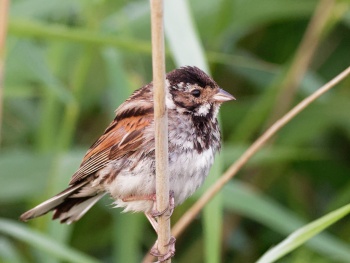Alternative name: Common Reed Bunting
- Emberiza schoeniclus
Identification
14-16.5 cm (5½-6½ in)
Breeding Male
Black head and throat, white neck collar and underparts, heavily streaked brown back, deeply notched tail with white edges.
In winter the black is obscured by rufous-buff edging.
The female and immature are much duller, though still heavily streaked, lacking the black head and white collar. A buff supercilium.
Legs reddish brown to black. Bill is dark and in most populations is small.
Similar species
Pallas's Bunting from eastern Siberia looks similar. However it's smaller, longer-tailed, the plumage is generally paler and it has a pale rump and gray rather than rufous lesser coverts.
Distribution
Europe and northern Asia. It has occurred several times as a vagrant to North America in Alaska.
Taxonomy
Subspecies
There are 19 subspecies[1]:
- E. s. lusitanica: Portugal and northwestern Spain
- E. s. schoeniclus: British Isles and north-western Europe to central Russia; winters to North Africa
- E. s. passerina: Breeds northwestern Siberia; winters in southern Asia, from northern India to western China
- E. s. parvirostris: Central Siberia and northern Mongolia; winters to northern China
- E. s. pyrrhulina: Transbaikalia to Kamchatka, Kuril Island, Sakhalin, Hokkaido
- E. s. pallidior: South-western Siberia; winters Caucasus to north-western India and Mongolia
- E. s. stresemanni: Eastern Austria, Hungary, northern Serbia, and northwestern Romania
- E. s. ukrainae: Southern Russia to northern Ukraine and Volga River; winters to Caucasus
- E. s. incognita: Russia east of Volga to southern Urals, northern Kazakhstan; winters to north-western China
- E. s. witherbyi: Northwestern Morocco, eastern Spain (including the Balearic Islands), Mediterranean coast of France, and Sardinia
- E. s. intermedia: Italy and Sicily east to Albania
- E. s. tschusii: Bulgaria and Romania east across the northern Black Sea to the Sea of Azov
- E. s. reiseri: Albania, Macedonia, and northern Greece
- E. s. caspia: Eastern Caucasus to western and southern Iran, Syria, adjacent south-eastern Turkey and north-eastern Iraq
- E. s. korejewi: Eastern Iran
- E. s. pyrrhuloides: Northern Caspian Sea region east to southeastern Kazakhstan
- E. s. harterti: Eextreme southern Russia (southern Tuva), extreme eastern Kazakhstan, northwestern China (Xinjiang), and western and central Mongolia
- E. s. centralasiae: Western China (Tarim Basin east to Lop Nur, Xinjiang)
- E. s. zaidamensis: Western China (Tsaidam basin in northern Qinghai)
Habitat
Breeds in almost any kind of marshy place: reedbeds, river banks etc but in winter will be found on farmland, particularly stubble fields.
Behaviour

Photo © by Shahrzad Fattahi
Tehran, Iran, 24 January 2019
Forms mixed flocks in winter with other buntings and finches.
Flight
Erratic bursts of wing-beats.
Diet
Their diet consists mostly of seeds and other plant material with the addition of insects when feeding young.
Breeding
They lay 4-7 eggs in a nest which is built in a bush or reeds
Vocalisation
Song: repetitious "tseek, tseek, tseek, tissick". Reed Bunting voice clip
References

Photo © by katastrofa
Rainham Marshes RSPB Nature Reserve, UK, 4 August 2019
- Clements, J. F., T. S. Schulenberg, M. J. Iliff, S. M. Billerman, T. A. Fredericks, J. A. Gerbracht, D. Lepage, B. L. Sullivan, and C. L. Wood. 2021. The eBird/Clements checklist of Birds of the World: v2021. Downloaded from https://www.birds.cornell.edu/clementschecklist/download/
- Hayman, P. & Hume, R. (2002) The New Birdwatchers Pocket Guide to Britain and Europe. Mitchell Beazley ISBN 1-85732-804-3
- Fitter, R. (1966) Collins Pocket Guide to British Birds. Collins
- Peterson, RT, G Mountfort and PAD Hollom. 1993. Collins Field Guide – Birds of Britain and Europe, 5th Revised edition. London: HarperCollins Publishers. ISBN 978-0002199001
- ID thread discussing subspecies E. s. pyrrhuloides]
- Brazil, M.A. (1991) The Birds of Japan. Smithsonian Inst. Press.
- Byers, C., J. Curson, and U. Olsson. (1995) Sparrows and Buntings: A Guide to the Sparrows and Buntings of North America and the World. Houghton Mifflin, Boston.
- Copete, J.L. & Christie, D.A. (2019). Reed Bunting (Emberiza schoeniclus). In: del Hoyo, J., Elliott, A., Sargatal, J., Christie, D.A. & de Juana, E. (eds.). Handbook of the Birds of the World Alive. Lynx Edicions, Barcelona. (retrieved from https://www.hbw.com/node/61900 on 8 April 2019).
- Howell, S.N.G., Lewington, I. & Russell, W. (2014) Rare Birds of North America. Princeton Univ. Press
Recommended Citation
- BirdForum Opus contributors. (2025) Reed Bunting. In: BirdForum, the forum for wild birds and birding. Retrieved 26 April 2025 from https://www.birdforum.net/opus/Reed_Bunting
External Links
GSearch checked for 2020 platform.1







